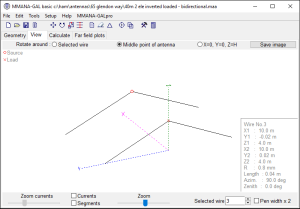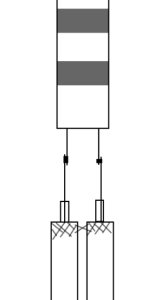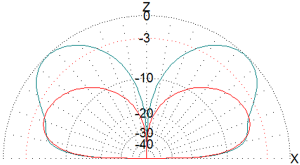I switched on the other evening and heard a very quiet DX caller on 7.142. It was YC0LOU from Indonesia and I could only pick up parts of his call. He called and called and had no takers. In fairness, he was extremely quiet but as the sun was gradually moving around the sky, he finally became audible and it was worth giving him a shout. 400w off my inverted V at 7m height got his attention but I needed a few blasts for him to get my call right. I put him on the cluster and he had a pile up.
Now, the point is, had I had more gain, I’d have not only heard him better, but he’d have heard me quicker too.
So I could add more height to my Inverted V but the difference between 7m and 10m isn’t actually that much at 5 degrees off the horizon – not even a db. Hardly worth writing home about.
 Anyway, this was the QSO that made me sit up and take stock of what I could do. I was seriously considering phased verticals for DX when I thought up the idea of having a switchable wire yagi. Either firing East or firing West.
Anyway, this was the QSO that made me sit up and take stock of what I could do. I was seriously considering phased verticals for DX when I thought up the idea of having a switchable wire yagi. Either firing East or firing West.
Like me, you may already have an inverted V dipole up for 40m, all you need to is build another one about a quarterwave in front – or behind your existing dipole but out of a single wire. You don’t need to feed this with coax, it’s a parasitic element, like a 2 element yagi.
 Having recently taken delivery of a Palstar AT4K manual tuner, I was keen to get her into production to replace my CG5000 in the attic.
Having recently taken delivery of a Palstar AT4K manual tuner, I was keen to get her into production to replace my CG5000 in the attic. After MUCH research, I finally used about 20 feet of parallel coax feeders, connecting ladder line to both ends. To clarify, I run about 12 feet of ladder line from the ATU to the parallel RG58 cables. I soldered the ladder line to the inner core of the RG58 coax and shorted the braid-to-braid. My 20 feet of RG58 runs to the attic, through walls, up ceilings etc and in reverse, I connected the ladder line to the RG58. Again, I shorted the braids of each line to each other with a solder blob. My ladder line then has another run to the feedpoint of a large 60m loop that runs through the attic and around the garden.
After MUCH research, I finally used about 20 feet of parallel coax feeders, connecting ladder line to both ends. To clarify, I run about 12 feet of ladder line from the ATU to the parallel RG58 cables. I soldered the ladder line to the inner core of the RG58 coax and shorted the braid-to-braid. My 20 feet of RG58 runs to the attic, through walls, up ceilings etc and in reverse, I connected the ladder line to the RG58. Again, I shorted the braids of each line to each other with a solder blob. My ladder line then has another run to the feedpoint of a large 60m loop that runs through the attic and around the garden.